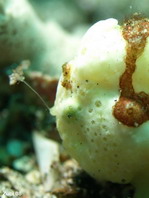
 www.frogfish.ch
www.frogfish.ch

The Antennarius pictus Group
Help with identification
Frogfish species are divided into groups of species related closer to each other. The Antennarius pictus Group encompasses species with a lure which is about twice as long as the second dorsal spine. All Frogfishes of this group show a lot of color variations and have round, darker spots (some also have ocelli) but never stripes.
Three of these Frogfishes are found in the Indopacific and belong to the Antennarius pictus Group: Antennarius commerson, Antennarius pictus and Antennarius maculatus. The distribution range of these three Frogfish-species overlaps in large parts.
I introduce these three frogfish species here seperately, because they are most commonly found by divers and are also most frequently confused with each other.
Two additional species from the Atlantic (Antennarius multiocellatus and Antennarius pardalis) are also part of the Antennarius pictus Group, but since they live in geographically narrow areas, their identification is much easier.
![]()
Lure (Illicium) and bait (Esca)
The identification of a Frogfish is linked to a close observation of the lure and the bait. Nevertheless even with the use of photos and further observations alone only a rough identification can be made.
The 3 Frogfishes from the Antennarius pictus Group all have different lures (illicium) and baits (esca). Unfortunatelly these two characteristics can't always be seen clearly.
|
|
|
The identification keys on this website are simplified. Ichthyologist use tables with the length of the illiciums and the number of dorsal, anal- and pectoral rays to exactely determine which species of Frogfish they have found. Examples can be found in the book Frogfishes of the World (Link to Google Books, choose page 30).
Example of a definite identification
| |
|
|
| |
|
|
| |
|
|
|
|
|
Difficult identifications
The three Frogfishes listed below look very similar and on first sight would probably all be identified as a Warty Frogfish. A close look shows, that they are a juvenile of the Painted Frogfish (A) and a juvenile Warty Frogfish with a skin which is not so warty as usual (B).
| |
|
| |
|
| |
|
| |
|
|
|
The colors
Unfortunately memebers of the Antennarius pictus Group can't be identified by their color, because each of these Frogfish species can have so many different colors.
![]()
Colors of the Giant Frogfish (to 30cm)
![]()
Colors of the Painted Frogfish (10-16cm)
![]()
Colors of the Warty Frogfish (8-10cm)
Juvenile:
The Warty Frogfish is the smallest of the three Frogfishes mentioned here and its range is also limited. As the name implies it's skin is very warty, a characteristic that the Giant Frogfish also has but diminished. Unfortunately the irregular shaped redish patches on the body radiating from the eye and forming a saddle are not a characteristic only typical for theis species but is found in variations with all three species. The Painted Frogfish also shows these characteristics and the juvenile of the Giant-Frogfishes looks nearly the same as the Warty Frogfish - only the lure is different.
![]()
Habitat
Antennarius commerson: Coral reefs, lagoons, outer reefs to about 30m depth. This Frogfish often perches on large sponges. It is perfectly camouflaged, so you nearly can't detect it although it is quite a large fish. It seems to like exposed areas, even where there is some current. Sometimes it is also found in sandy areas, if there are large sponges growing there or on ropes or under jetties.
Antennarius pictus: shallow, protected reefs, lagoons, sandy areas. The Painted Frogfish is found in different habitats form sandy areas covered with algea and sponges to coral reefs. The prefer to live close to or on top of colorful sponges and change their skin color accordingly.
Antennarius maculatus: shallow, protected reefs between algae, sponges and soft corals. To about 20m depth.
Range
The range of the three Frogfish species from the Antennarius pictus group largely overlap .
Antennarius commerson: Red Sea, Indopacific
to the Society islands, Eastern Pacific, north to Southern Japan.
Antennarius pictus: Red Sea, Eastern Africa
to Hawaii and Southern Japan to Australia.
Antennarius maculatus: Mauritius to Solomon
islands, Papua New Guinea, probably New Caledonia, mainly the Philippines
and Indonesia.
Map: Range of the Frogfishes Antennarius commerson, Antennarius maculatus und Antennarius pictus according to Fishbase



























































